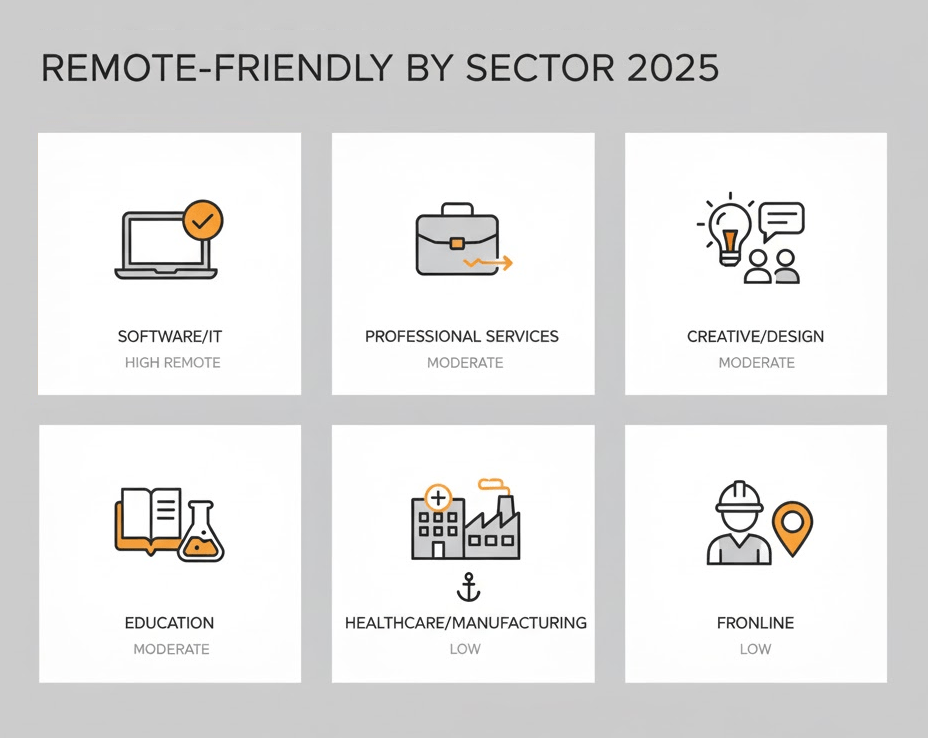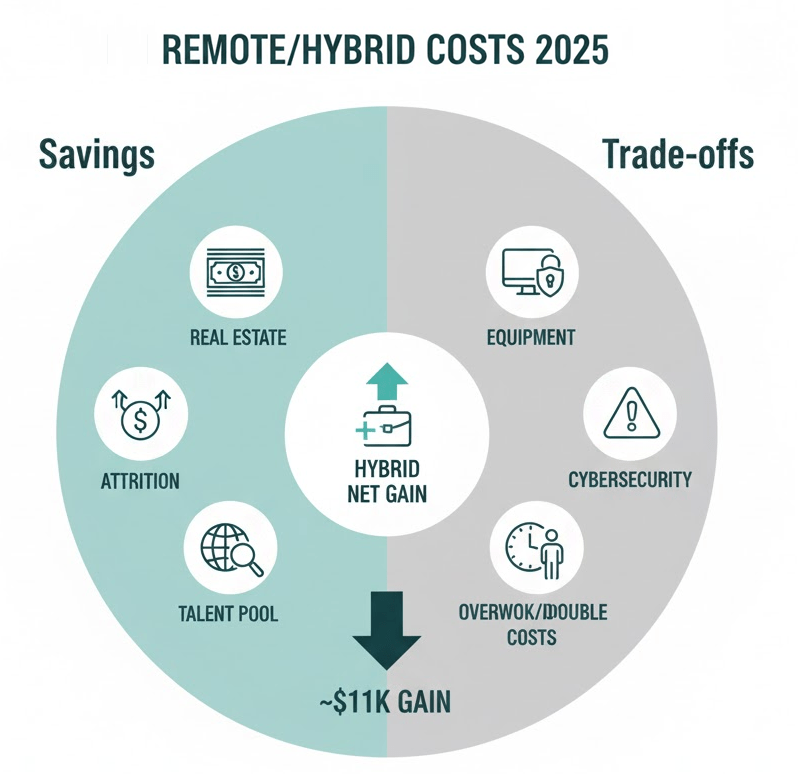The debate over whether remote workers outpace their office-bound colleagues rages on, fueled by evolving work models, emerging technologies, and a post-pandemic workforce that insists on flexibility. As of October 2025, the picture is complex: remote and hybrid setups often hold a productivity edge, but much depends on industry, role type, managerial practices, and technological infrastructure. Below is a deeper dive — plus actionable takeaways — for leaders and teams navigating this landscape.
Remote Work’s Productivity Edge: Myth or Reality?
At first glance, remote work appears to confer measurable advantages. Reduced commuting, quieter environments, and fewer interruptions can allow deeper focus. Indeed:
- The U.S. Bureau of Labor Statistics (BLS) reports a positive correlation between increased remote work and total factor productivity growth across business sectors in the 2019–2021 and 2019–2022 periods. A one percentage-point increase in remote workers is associated with a 0.08 percentage-point rise in total factor productivity growth.
- McKinsey’s research suggests that with the right operating models, remote setups can enhance organizational health and efficiency, particularly when leaders focus on practices over rigid policies.
- Among the 2025 Fortune 100 Best Companies to Work For, nearly all (98%) embrace some form of remote or hybrid work, and these organizations show 42% higher productivity compared to average U.S. workplaces.
- Remote employees also report time savings: ActivTrak data shows they save an average of 72 minutes per day from eliminated commutes, with 35–40% more productivity overall and many redirecting that time to work activities.
That said, remote’s productivity advantage is not uniform or guaranteed.
Where Remote Falters
- In fully remote settings, meta-analyses estimate a 10% productivity drag relative to in-person teams, largely due to coordination friction and fewer spontaneous idea exchanges.
- Certain industries — manufacturing, labs, retail, frontline services — simply can’t decouple output from physical presence, as core tasks demand on-site equipment or interaction.
- In remote meetings, employees may multitask more aggressively (switching windows, checking email), which can erode focus and group cohesion. A large-scale Microsoft study of meeting telemetry documented this behavior across remote sessions.
- Burnout and “always-on” pressure also rise, especially when remote boundaries are poorly managed — a phenomenon known as digital presenteeism, where constant online visibility signals productivity at the cost of well-being.
In short: remote work can enhance productivity, but it also introduces fragilities that must be addressed.
Hybrid Models: The Middle Way That Often Works
Pure remote may swing too far; full-time office may be too rigid. Hybrid models, blending remote and in-office days, are proving to be the sweet spot in many contexts.
Evidence in Favor
- A large Stanford-led study of 1,612 Trip.com employees found that working from home two days a week preserved productivity and promotion prospects while reducing attrition by 33%. — the study was published in the journal Nature
- The NBER working paper “How Hybrid Working From Home Works Out” finds that by early 2023, roughly 30% of fully paid working days were remote, with hybrid schedules (2–3 remote days) becoming the norm.
- Stanford’s policy brief argues that hybrid balances the productivity plus connection tradeoff, and is increasingly the sustainable model.
- McKinsey notes that as of fall 2022, 56% of survey respondents across multiple geographies held hybrid arrangements (1–4 office days per week).
Risks & Critiques
- Some contemporary voices warn hybrid still isn’t serving all organizations well: leadership misalignment, cultural fragmentation, and uneven adoption can dampen the benefits.
- In hybrid teams, the “in-office days” often become default collaboration days, so remote days can become second-class or isolated unless managed deliberately.
Overall, hybrid is rarely perfect, but when executed well, it can extract both flexibility and connection.
Industry & Role Fit: Where Remote, Hybrid, or Office Make Sense

To sharpen decision-making, overlay productivity insights with industry and role sensitivity.
| Sector / Role Type | Likelihood Remote-Friendly | Caveats / Hybrid Necessities |
|---|---|---|
| Software / IT / Data / Cloud services | High | Remote works well; ensure tooling, async norms, strong documentation |
| Professional services (consulting, law, accounting) | High to moderate | Some client-facing meetings may demand occasional office presence |
| Creative / design / media | Moderate | Brainstorming and studio collaboration often benefit from in-person time |
| Education / research / training | Moderate | Labs or classrooms require on-site presence; some course theory work remote |
| Healthcare, manufacturing, hospitality | Low | Physical infrastructure or face-to-face service makes remote less viable |
| Frontline / field operations | Low | Remote may enable administrative tasks, but core work remains on-site |
Also, task type matters: deep, focused work is often remote’s sweet spot; creative ideation, mentoring, onboarding tend to benefit from face-to-face interaction. McKinsey’s “Future of Remote Work” analysis reiterates this: remote potential is highly concentrated in a subset of occupations and tasks.
Cost Dynamics: Hidden Savings and Trade-offs

Productivity is one side of the ledger — costs are the other. Here’s a breakdown of cost dynamics:
Remote / Hybrid Savings
- Real estate & facilities: Fewer desks, smaller offices, lower utilities.
- Commuting reimbursements / parking: Cuts in transport subsidies.
- Attrition & hiring: Greater flexibility can reduce turnover costs.
- Expanded talent pool: You can recruit in lower-cost geographies.
Studies estimate savings of ~$11,000 per employee per year in many hybrid models thanks to reduced overhead and physical footprint.
Hidden or Deferred Costs
- Home office equipment & stipends: Laptops, ergonomic furniture, broadband upgrades.
- Cybersecurity & IT management: Remote expands the attack surface; companies must invest in secure VPNs, endpoint protection, monitoring.
- “Double costs” in hybrid: Maintaining both an office and remote support infrastructure.
- Overwork & burnout: If boundaries erode, people may work longer hours unsustainably (which can have longer-term costs).
- Coordination inefficiencies: Wasted time in meetings, sync-up delays, versioning conflicts.
A comprehensive cost-benefit evaluation helps decide which model (remote, hybrid, or office-heavy) fits your organizational structure and budget.
People, Culture & Equity: The Harder Part of Productivity
Productivity does not emerge spontaneously—it’s seeded through culture, trust, policies, and people systems.
Trust and Psychological Safety
High-trust environments see remote productivity advantages magnified. In the Great Place to Work 2025 analysis, companies on the Best Companies list showed ~42% higher productivity and stronger cooperation culture. Clear expectations, autonomy, and fairness help mitigate the sense of “out of sight, out of mind.”
Career Development & Inclusion
- Remote workers risk proximity bias: fewer ad hoc conversations, less visibility to decision-makers.
- Hybrid models often help balance that by ensuring remote employees have in-office days for engagement.
- Remote work can expand access for people with disabilities, caregivers, or those outside major metros—if organizations build inclusive training, mentorship, and communication systems.
Well-Being & Boundaries
- Remote flexibility is a boon, but it can also lead to overwork and blurred boundaries—employees may feel pressure to respond after hours.
- Regular wellness check-ins, asynchronous norms, “offline hours” policies, guidance on work–life boundaries are essential.
AI & Productivity: The 2025 Accelerator
AI is evolving from a mere sidekick to a powerful amplifier of productivity in the remote and hybrid work landscape.
- Users of generative AI tools report weekly time savings equivalent to ~5.4% of work hours, which maps to a ~1.1% productivity lift.
- McKinsey estimates that AI could unlock $4.4 trillion in annual corporate value via use cases like process automation, intelligent summarization, predictive insights, and task orchestration.
- In hybrid/remote teams, AI tools help with asynchronous communication, auto-notes, meeting summarization, scheduling optimization, and context-aware reminders—closing coordination gaps.
- In roles previously disadvantaged by remote setups (e.g., frontline or support roles), AI adoption is leveling the playing field—some workers now access tool-augmented interfaces that reduce manual work and match remote productivity.
As Microsoft notes, AI is turning flexibility from a perk into a “productivity amplifier” for the highest-value work, especially in hybrid environments.
The Verdict: Context Trumps Absolutes
Remote work is not a magical panacea—but for many knowledge-intensive, independent, and medium-to-senior roles, it can deliver material gains (some studies report productivity improvements up to 30–40%). Hybrid models often offer the most balanced approach, sustaining connection, visibility, and flexibility with modest risks.
The true differentiator in 2025 is how well organizations equip employees—not just where they log in. That means investing in training, infrastructure, inclusive culture, clear workflows, and now, AI systems that support remote/hybrid collaboration.
Below is a suggested checklist for leaders considering (or refining) remote/hybrid policies:
Leader’s Remote/Hybrid Readiness Checklist
- Role & Task Audit
- Classify roles by remote feasibility (deep work, creative, client-facing, hands-on).
- For borderline roles, pilot hybrid schedules first.
- Technology & Infrastructure
- Ensure robust connectivity, cloud collaboration platforms, endpoint security.
- Deploy AI tools for meeting summarization, task automation, async notes.
- Cultural Anchors & Trust
- Establish clear expectations, outcome-based metrics, virtual rituals, communication norms.
- Train managers in remote leadership and bias awareness.
- Equity & Visibility Mechanisms
- Rotate in-office days for remote staff.
- Use structured performance reviews, cross-team visibility, mentorship programs.
- Health & Boundaries
- Institute “quiet hours,” encourage regular breaks, monitor hours worked versus output.
- Provide mental health resources and remote social connection outlets.
- Cost-Benefit Modeling
- Quantify real estate vs. remote costs (stipends, security, support).
- Assess long-term hiring, retention, and talent access gains.
- Iterate & Reassess
- Run pilots, collect data (employee satisfaction, output metrics, turnover).
- Be ready to adjust, scale up, or roll back models.












